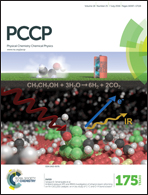Assessing covalency in equatorial U–N bonds: density based measures of bonding in BTP and isoamethyrin complexes of uranyl†
Abstract
Calculations performed at the density functional level of theory have been used to investigate complexes of uranyl with the expanded porphyrin isoamethyrin and the bis-triazinyl-pyridine (BTP) ligands, the latter of which is well-known to be effective in the separation of trivalent lanthanides and actinides. Analysis has been performed using a range of density-based techniques, including the Quantum Theory of Atoms in Molecules (QTAIM), the Electron Localisation Function (ELF) and the reduced density gradient (RDG). The effects of peripheral alkyl substituents on UO2-isoamethyrin, known to be vital for proper replication of the experimental geometry, are considered. Evidence for comparable amounts of covalent character has been found in the largely ionic U–N bonds of UO2-isoamethyrin and [UO2(BTP)2]2+ and examination of the variation in the electronic characteristics of the uranyl unit upon complexation in both of these cases reveal striking similarities in the nature of the U–N bonding and the effect of this bonding on the U–Oyl interaction, as well as evidence of donation into the U–N bonding region from the uranyl unit itself.



 Please wait while we load your content...
Please wait while we load your content...